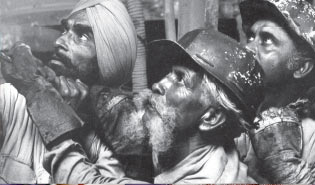-
1920s
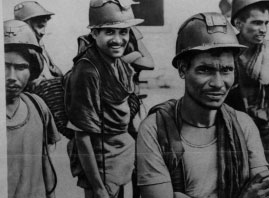
1920s: Jamshedpur Labour Association established
1922s: Second strike launched and management withdrew its recognition
1925s: Conciliation committee with C R Das as Chairman formed. to break the deadlock. Mahatma Gandhi visited Jamshedpur and recognition of the Union was restored
1928s: Subhas Chandra Bose inducted as President
TISCO witnessed strike for the last time and thus ushering an era of Industrial Harmony
![]()
Gandhi's message to workers, 1925

It was my ambition to see one of the greatestif not the greatest – Indian enterprises in India, and study the conditions of work here. But none of my activities is one-sided, and as my religion begins and ends with truth and nonviolence, my identification with labour does not conflict with my friendship with labour... ...And believe me, throughout my public service of 35 years, though I have been obliged to range myself seemingly against capital, capitalists have in the end regarded me as their true friend. And in all humility I may say that I have come here also as a friend of the capitalists - a friend of the Tatas.
-
1930s
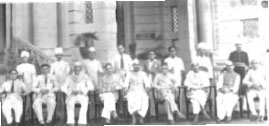
1934: Profit Sharing Bonus was introduced
1938: Jamshedpur Labour association re-christened as Tata Workers' Union
1939: Jawaharlal Nehru and Rajendra Prasad visited Jamshedpur to further strengthen the Union - Management harmony
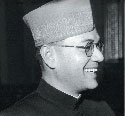
Jamshedpur as an industrial centre has a special importance because it is an epitome of India and people from all provinces congregate there. It should be the object of every wellwisher of labour to build up an ideal labour organization there.
The Company is helping labour not only by recognizing their association but also by collecting monthly subscriptions on pay day on behalf of the Labour Association
-
1940s
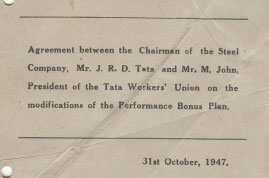
1942: Tata Workers' Union leaders took active part in the 1942 Quit India Movement
1945: Study Leave introduced
1946: The Agreement of 1946 signed
1947: Prime Minister Jawaharlal Nehru wrote to JRD Tata "I am also glad that you have taken further steps to remove discontent and re-establish the morale of the workers"
1947: Personnel Division of Tata Steel formed
1948: TWU opened unit for the Supervisors and Technicians
-
1950s
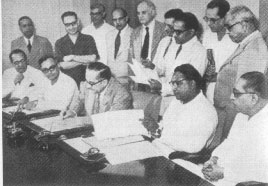
1954: Tata Workers' Union introduced sickness benefit scheme for members
1956: The famous Agreement of 1956 signed
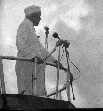
Jawaharlal Nehru's message to workers, 1958
I wanted to come not only because of the importance of this great steel works here and this city Jamshedpur, but even more so because this place has become symbolic in some ways of the growth of Indian industry.
-
1960s

1962: TWU run two high schools for the education of member's children. Government of Bihar took over the charge of these schools later
1969: Memorandum of Settlement was signed between the Management and the TWU
-
1970s
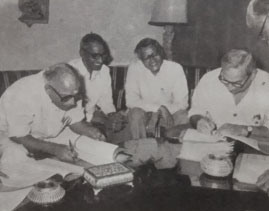
1977: Michael John, President TWU passed away on August 3, 1977
1977: TWU opposed the Government of India's plan to nationalize Tata Steel
1978: Life Cover Scheme was introduced
1978: Tata Workers Union moves into their building on March 19, 1978
1970s: Wage Agreements were signed between the Management and TWU in 1970, 1975, 1978
-
1980s

1980: The first Social Audit Report submitted
1980: Sick Leave Encashment Scheme introduced
1983: Wage Agreement signed between Management and TWU
1984: Michael John Centre for Research and Human Resources development set up
1987: TWU's Information Centre and Library inaugurated on January 1
1989: Pension Scheme introduced
1989: TWU's in house journal "Mazdoor Awaz" commenced publication
1989: Wage Agreement signed between the Management and the TWU
-
1990s
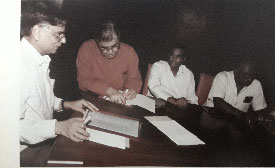
1990: Medical Separation Scheme introduced
1995: Employees Family Benefit Scheme (E.F.B.S) launched
1995: Early Separation Scheme introduced
1995: Memorandum of Settlement between Management and TWU
1999: Wage Agreement signed between the Management and TWU
-
2000s
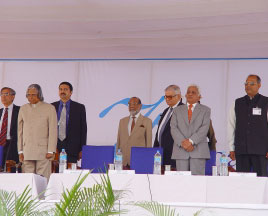
2001: Wage Agreement signed between the Management and TWU
2001: Family Benefit Scheme launched
2002: Shabash launched. The company took another remarkable step in extending its appreciation to its employees with the launch of "Shabash", a new scheme for instant rewards and recognition for significant contribution by unionised employees
2003: Bonus agreement signed
2003: RD Tata Technical Training Centre established
2004: 75 Years of Industrial Harmony celebrated
2008: Memorandum of Understanding signed between Management and TWU for Annual Bonus for the accounting year 2007-08
-
2010s
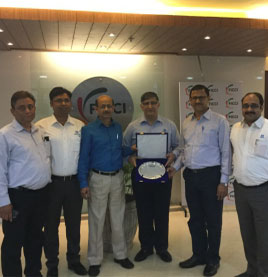
2012: Suraksha Scheme for Contract Labour introduced in 2012
2014: Family Support Scheme introduced
2016: Tata Steel bags the 'National Award for Outstanding Achievement in Industrial Relations' by All India Organisation of Employers (AIOE)
2019: Paternity BenefitScheme introduced
 Corporate
Corporate
 Sustainability
Sustainability
 Products & Solutions
Products & Solutions
 Investors
Investors
 Media
Media
 Careers
Careers
 Contact Us
Contact Us






















